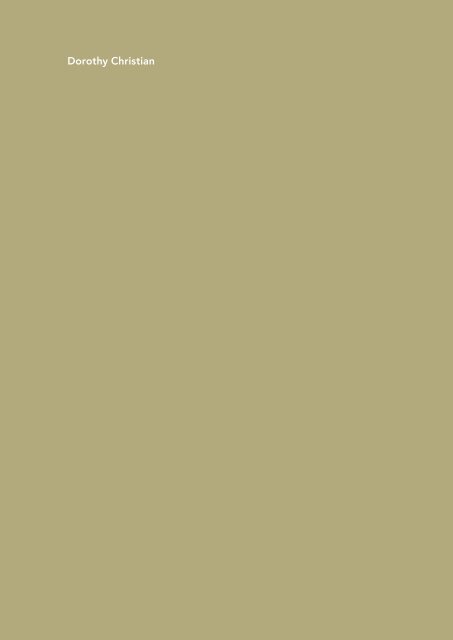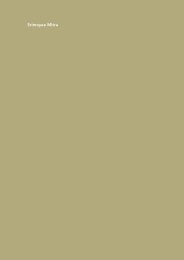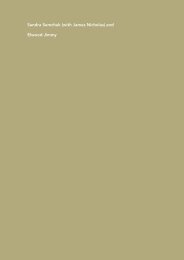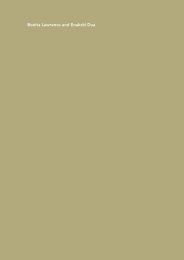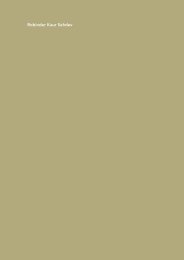Dorothy Christian - Speaking My Truth
Dorothy Christian - Speaking My Truth
Dorothy Christian - Speaking My Truth
Create successful ePaper yourself
Turn your PDF publications into a flip-book with our unique Google optimized e-Paper software.
<strong>Dorothy</strong> <strong>Christian</strong>
<strong>Dorothy</strong> <strong>Christian</strong>’s Secwepemc (Splatsin) name is Cucw’la7 meaning Meadowlark. In2007, the old ladies from her community named her this because “she is not afraid totalk....she won’t hide anything that has to be revealed, like the meadowlark she travelsto see all and [to come home to] talk about it.” <strong>Dorothy</strong> is the eldest of ten, has onedaughter and over fifty-five nieces and nephews and great-nieces and -nephews. Shehas never been to residential school, but was affected intergenerationally because hermother, her aunt, her uncles, and her cousins are residential school Survivors. <strong>Dorothy</strong>and her siblings are survivors of the next generation of assimilation policies that putthem into white foster homes during what is known as the Sixties Scoop. In her life pathshe seeks truth and reconciliation on all levels: personally, politically, professionally, andspiritually. <strong>Dorothy</strong>’s reclamation of her Indigenous spiritual ways led her to the BlackHills of South Dakota to find her personal truth where she fasted under the guidance ofa Sioux Medicine man in 1990. A watershed year that opened up an exploration of whatan authentic political truth and reconciliation with the settler peoples in Canada means.<strong>Dorothy</strong> is currently in Ph.D. studies at the University of British Columbia where she isseeking to reconcile Indigenous and Western systems of knowledge.
Reconciling with The People and the Land?What is truth and reconciliation to this Secwepemc–Syilx (Shuswap–Okanagan) woman whose homelands lie within a geo-political state where thePrime Minister claims, “We also have no history of colonialism”?1 How does thatlack of political will trickle down to the day-to-day activities of my life? I did notattend residential school but my Mother, Aunt, and Uncles did. However, I ama survivor of the “60 s Scoop,” which was the next wave of assimilation policiesthat separated me from my Indigenous family and put me in five foster homesin five years time. I ran away every time to go home to see my Granny. She toldme, “Go to school, we need to know how those people think.”Luckily, I have a mind for school, but before I could pursue my academicstudies, I had to deal with some harsh life lessons that had me “wast[ing] alot of time spinning my wheels in a destructive anger.”2 In the late 1980 s, Istarted consciously to seek healing from the horrific life experiences thatcolonialism wrought upon me, my family, and my community. In orderto do that, I put Indigenous and settler relationships under scrutiny. Likemost people, I only thought of white people as settlers; however, as myhealing journey evolved and my experience expanded I turned my attentionto non-white settlers too. <strong>My</strong> examination of Indigenous intersectionswith non-white settlers from other races, identities, and cultural groupsconsciously3 started when I began working on a diverse team of producerswith Rita Shelton Deverell at Vision TV where I met Muslims, Hindus, Sikhs,Zoroastrians, Buddhists, Jews, and <strong>Christian</strong>s who came from many differentraces and cultures. This article is a reflection on some of my healing journey;part of that is seeking a peaceful co-existence with settler folks.The slide plate under my microscope focused in a very up-close and personalway during the so-called 1990 Oka Crisis in Mohawk territory and thenthe 1995 Gustafsen Lake standoff in Secwepemc territory. I worked behindthe scenes in communications at these two armed land rights conflicts toelevate consciousness to the international media. During the GustafsenLake standoff, Ipperwash was happening in Ontario at the same time. Iexperienced first-hand the psychological warfare of the Canadian military.4<strong>My</strong> healing journey towards my truth and reconciliation with the settlerCultivating Canada | 71
peoples was catapulted forward by these two life-changing events. Sincethese modern-day Indian wars where two lives were lost5 I have been asking,“Is it possible to have peaceful co-existence within a state that denies itscolonial history and will mobilize their military against the Original Peoples?”During the 1990 s, a highly volatile time in Canada, Indigenouscommunications were largely ignored by the national media while mostsensationalized the violence and promoted coverage that “racialized andcriminalized” images of the people defending the land rights. In the 1990 78-day siege, only one media outlet, the multi-faith and multicultural broadcaster,Vision TV, picked up on my press releases about a peaceful, spiritual crosscountryrun initiated by the Syilx (Okanagan) and the Secwepemc (Shuswap).In 1995, during the Gustafsen Lake standoff, my cell phone was scrambled andthe RCMP media liaison tried to exclude me from the press scrums. I refusedto be intimidated and declared that I was accredited media and worked for anational broadcaster, but I and my questions were ignored in the subsequentpress scrums where I was the only person of colour.After 1990 I wanted to leave this country, which had demonstrated suchhateful behaviour towards us, but then I thought, “Where would I go, thisis my homeland. This is where my people have been for generations andgenerations!” Since then I have often wondered what immigrants thinkwhen they come to this country. I wonder what it feels like to leave theirhomelands, especially the more recent immigrant groups who are largelynon-white and are forced to leave their traditional lands because of war,political instability, or other untenable circumstances.Many other questions arose in the following decade while I uncoveredwhat truth and reconciliation mean to me. <strong>My</strong> interrogation centred onhow Indigenous peoples relate to the settler peoples who have chosen ourhomelands as their place of residency. This line of questioning motivatedmy engagement in many activities. When I examine my personal andpolitical involvements since the 1990 s, I see that my work has focused onmany facets of Indigenous and non-Indigenous relationships in Canada.Following Oka, I developed a relationship with Rita Shelton Deverell whowas then Vice-President of Production and Presentation at Vision TVand one of the founders of the specialty station, which is the only multifaithbroadcaster in the world. She mentored and trained me to producefor television and contracted me as part of a team of multi-faith andmulticultural producers from across Canada for eight television seasons.Rita’s leadership had a critical impact in my quest of examining whether ornot a peaceful coexistence was possible with settler cultures in Canada.72 | <strong>Dorothy</strong> <strong>Christian</strong>
One significant memory I have is at an annual party at Rita’s home in Toronto.I remember standing at the edge of the room with my camera eye on andwatching my fellow producers from all cultures and faith groups, some ofthem dressed in their traditional garb, dancing, and some people laughingas they engaged in lively conversations. I thought how incredible this scenewas, and I wished Canadians could see this. Here we were individuals fromthe spectrum of the multicultural mosaic of Canada, all working towardsupholding the mandate of the program, which included peace. This doesnot mean we all agreed on political, social, or spiritual issues; however, wewere able to go beyond the parameters of the “tolerance” policies of diversityand actually extend respect to each other’s point of view. I have come torecognize my time at Vision TV as a very blessed experience because racism,sexism, and homophobia were given assumptions when producing ourstories. I may have an idealistic memory of my experience because I was notlocated in Toronto where, no doubt, there were the usual office politics thatI was thankfully not a part of. However, I do know from this experience thatit is possible to work in a peaceful way while coexisting with other culturalgroups in the cultural interface.Throughout the evolution of my multi-dimensional identity—that is, mypersonal, political, social, spiritual, and academic development—I havelooked closely at the intersections of race, identity, and culture, includingthe multiple histories of the settler peoples in coexistence with Indigenouspeoples. <strong>My</strong> quest started by examining the “white people” settlers, whichI discuss extensively in The History of a Friendship or Some Thoughts onBecoming Allies.6In my history with Victoria Freeman, a thirteenth-generation NorthAmerican settler,7 we have decolonized ourselves and looked at whatinstitutional decolonization might look like. Decolonization is one of thosebig conceptual words that encompass many things and no doubt meansdifferent things to different people. For me it meant dealing with the deeplyembedded racism we felt towards each other and deconstructing the manypreconceived notions we had about each other to finally reach a placewhere we can honour each other’s dignity and achieve a true reconciliationas human beings. Luckily, both Victoria and I had the tenacity and desireto develop our decolonized relationship. It is a difficult and sometimesheartbreaking process that requires a level of commitment to a relationshipthat is rarely found in friendships.In 2003, Victoria and I were invited to a conference in Switzerland wherewe addressed an audience of 700 people from diverse cultures from aroundCultivating Canada | 73
the world. We co-presented about our colonizer-colonized relationship inCanada. In my talk, I suggested the colonization process was brutal andthat both sides of the colonial divide needed to engage in a healing process.However, before healing could begin, the reality of the situation had to beacknowledged.When referring to my relationship with the colonizers of my land, many timesI apply the metaphor of an abusive relationship; that is, as a ‘colonized’ personI am the assumed victim, and the colonial state, including the settlers, is theoffender. In an abusive relationship, the offender controls the situation with aconstant threat of violence that creates a situation where both parties ‘walk oneggshells’ around each other because at any given moment violence may erupt.In the dysfunctional relationship between Indigenous peoples and the settlerpeoples of North America, there is an undefined ‘walking on eggshells’ thatsits between us as a ‘pregnant pause’ or as a very LOUD silence.8I see the three armed conflicts in Canada during the 1990 s as Indigenouspeoples “breaking the silence” about the abusive behaviour of the colonizingsettler governments in Canada. When a victim breaks the silence in an abusiverelationship, this is a clear call for change because the status quo of the oldrelationship is no longer acceptable. If both parties take responsibility for theiractions and/or non-actions, then the healing can begin.In our old relationship with the settlers, there is a normalized notion of whiteEuropean settler peoples; however, in this time of globalization, the settlerface has changed to include the faces of the many, many other peoples fromdiverse cultures who immigrate to our homelands, seeking a new home. Nowthe settler face includes people from all the countries of the African continent,people from China, Taiwan, Hong Kong, Japan, India, Pakistan, EasternEurope, countries of the Middle East, the South East Asian countries, such asMalaysia, Indonesia, and Thailand, and people from the UK, Australia, andNew Zealand continue to immigrate to these lands.In 2002, when writer Lee Maracle was scholar-in-residence at the Universityof Western Washington in Bellingham, she hosted a conference to discussNative–Chinese relations that set off a chain of involvements for me. In 2004,I started researching a film on Native–Chinese relations in my territories,which started an exploration of the relationship with one of the longeststanding, non-white settler communities in Canada. I found stories in ourshared oral histories that revealed how Indigenous peoples have familialrelationships with the Chinese that started in the late 1800 s.9 I discoveredthat economic partnerships were developed in the mid-1950 s in the interiorof BC where Chinese farmers leased lands on reserve and hired Indigenouspeople. In August 2004, I was invited to speak at a “Walk with WomenWarriors” workshop in Chinatown10 where I acknowledged our shared74 | <strong>Dorothy</strong> <strong>Christian</strong>
oppressions and discussed some of the shared history I had uncovered.11 Atthe end of my talk, I asked the Chinese community who would be standingnext to me the next time an army tank is coming at me? Since then myconversation with the settler peoples of Canada has expanded and evolved.In September 2007, I was invited to participate on a conference panel,“Women, Resistance, and Cultural/Community Activism—Catalyzing Agents:The Ethics of Doing ‘Asian Canadian’,”12 where I took the opportunity toexpand the conversation, beyond the Chinese–Canadian communities, toinclude the Japanese–Canadian and Indo–Canadian participants. I explainedthat this was not a comfortable conversation for me as the only Indigenousperson in the room; however, growth and change can only happen when wedeal with the hard issues. At the end of my presentation, I asked them whenthey were going to start giving back to the lands they had chosen as their newhome and, also, what they would give back.In February 2009, I was invited to do a keynote address at the University ofVictoria’s Diversity Conference, “Critical Conversation Continue,” wherethe spectrum of settler communities was represented in the communityengagedresearchers, students, faculty, and community members. <strong>My</strong> talkwas an hour long so I was able to link a number of issues; however, theprimary focus was media (mis)representation of Indigenous peoples inCanadian programming. I started with wartime images, peacetime images,and then discussed alliance building. In looking at how the Canadianscreen culture manages the visual narratives about Indigenous peoples, Igave a critical analysis of some of the television programming in Canada. Inmy keynote address, I included:How many of you watch Canadian TV? Have any of you seen The Border? It’squite an exciting and very dynamic series produced by Peter Raymont at theCBC. It’s been receiving lots of attention. I make a point of watching it, notonly because I like the stories but because from time to time, they includeIndigenous people in their scripts. The writers of that series have not erasedus. They are dealing with contemporary race issues in Canada at the fictionalimmigration agency.On the other hand, another CBC series, Little Mosque on the Prairie totallyexists in a bubble. Apparently, this Muslim community in Saskatchewanhas no Cree, Métis or Sioux people in that little town. I stopped watching theseries when I saw that we weren’t included in the scripts. I sent a question viatheir blog; I asked the writers of the series why their scripts do not include theIndigenous peoples of Saskatchewan. And of course I have not had a response.Ironically, this series has been syndicated in the Middle East where the landissue between the Palestinians and the Israelis is the cause of a major war(that has huge global implications); yet, here in Canada they do not deal withthe original peoples who also contest the presence of the settlers on the land.13Cultivating Canada | 75
While I understand the necessity of creative freedom in writing scripts, is itnot the ethical responsibility of the writers of Canadian series television toalso address the complexities of living on the lands of the Original Peoples?How many Canadian producers hire Indigenous writers for their writingteams? When will Canadian producers stop bringing us in as mere “culturalconsultants” for our opinions/suggestions, which are rarely incorporated andhardly ever includes the opportunity to submit an invoice for our time? Whenwill they start hiring us for the substantive key creative positions as directors,directors of photography, or as supervising editors? There are enough of uswith experience and training now.It’s complicated, but it is all interrelated. At the University of Victoria, I alsolinked Indigenous–settler relations in terms of the environment; the landsthat people have chosen to make their home. At the Victoria conference Iexplained how, in many Indigenous cultures, there is a concept of givingback—it is complicated yet very simple. For instance, when we go out on theland, we don’t take more than what is to be used for that season. If a personis being responsible, they will give back to the land by taking care of theirpicking grounds, they will do what is needed to take care of those lands thatprovide food. Another simpler example is when we go and harvest treesand branches to build a sweat lodge, we offer tobacco and ask the tree forits blessing as we explain what the branches are to be used for. Of course, Iacknowledge it is much more complicated in human relations. <strong>My</strong> point is,we can’t just keep taking and taking and taking and not give something back.Settler peoples come from all over the world to these lands to reap thebenefits of this land of milk and honey, and they send their financial andother resources to their homelands. What do they give back to the OriginalPeoples of these lands? Do they ever take the time to learn about theIndigenous people whose lands they occupy?In the healing process, once the silence is broken and each party is takingresponsibility for their part of the relationship and relating to each other asdignified, autonomous human beings, then a new relationship can begin. Isee that a new way of being in the cultural interface of Indigenous peoples andall settler communities has to begin with a shared active engagement in thedecolonizing process while simultaneously participating in a cultural healingof both communities, which I believe is necessary for both Indigenous peoplesand non-Indigenous settler peoples of Canada.One of the major things I have learned from my intercultural relationshipswith both white and non-white settlers is that it is critical to relate outsideof the usual colonial binary of the colonizer and the colonized. In this76 | <strong>Dorothy</strong> <strong>Christian</strong>
approach, Indigenous peoples are consistently relegated to the “victim” role,which paralyzes our ability to assume responsibility for our actions andlocks us in the perceptions of the common stereotypes; that is, the “noblesavage,” Hollywood’s monosyllabic Tonto, the stoic cigar store Indian, therebellious Billy Jack hero, the natural environmentalist, or the all-knowingspiritual Medicine Man or Woman. You know, the one with all that “woo-woo”spiritual energy who can do magical things!In my intercultural work, the primary focus has been searching for andtrying to understand what “peaceful coexistence” means in the culturalinterface for Indigenous peoples who want to maintain their ancestral tiesto their homelands, yet work together with the larger societies in seeking asustainable environment where Indigenous peoples can finally realize someeconomic benefits. How can we work together? How do we stand togetherin alliances to fend off the globalization machine that perpetuates a neocolonialapproach? The land is integral to Indigenous cultures and, I argue, isthe cause for the very “LOUD silence” that sits between us because “I believethis is founded in the fear that Indigenous peoples want the land back, thatour suppressed rage compounded over centuries will explode at any giventime on any given territory.”14Settlers know that the original peoples of Canada have a birthright to ourlands and any benefits from its resources. I truly believe the denial of thisentitlement and the lack of integrity that the settler governments have in thecolonial relationship is at the core of this fear. Settler governments know theyhave assumed a privilege and an entitlement to these lands; yet, at the sametime they deny the privilege and entitlement of Indigenous peoples.15Although many Canadians in the interfaith groups and cultural activists maytheoretically understand the lack of integrity of the governments assumingthis privilege on the land, it is difficult to exercise effective political actionsthat may change the status quo, because any real change is neutralized bydiversity policies.Over the years, I have witnessed how we come together oh-so-politely underthe diversity policies that promote being tolerant of each other. I have sat inmeetings where we are working together on a shared goal; however, whenit comes to the human part of developing relationships, many people haveto run to other meetings, answer phone calls/texts, or some other moreimportant activities. Admittedly, most of the people who are engaged inintercultural/interfaith work are overtaxed as it is, and until we take the timeto get to know each other as human beings, I see the activist communitygetting stuck in the policies of regulating aversion,16 rather than engagingin a truly respectful, collaborative, and peaceful approach. In her book,Cultivating Canada | 77
Regulating Aversion: Tolerance in an Age of Identity and Empire, Wendy Brownsays, “It is noteworthy, too, that within this [tolerance] discourse the aim oflearning tolerance is not to arrive at equality or solidarity with others but,rather, to learn how to put up with others.”17 If what Brown says is true thatthe tolerance discourse of Western liberalism regulates the presence of theOther both inside and outside the liberal democratic nation-state and thatthe notion of tolerance “affects all levels and domains of civil engagement”18while it acts as a “substitute for or as a supplement to formal liberal equality[that can] block the pursuit of substantive equality and freedom,”19 thenindividuals and groups within the nation-state of Canada need to formulatenew models of interrelating outside a tolerance discourse (including diversityor multicultural policies) that literally paralyzes a substantive reconciliationin this pluralistic society.For me, part of reconciliation is taking the time to build respectfulrelationships and to create opportunities where we develop a new model ofinterrelating, a model that takes us beyond the usual multicultural sharingof food and dance and walks towards an authentic reconciliation. This willrequire a complex, multi-faceted approach; however, if the political will anddesire of settler and Indigenous communities are there, I truly believe it ispossible to build a peaceful coexistence with each other.Some of this is happening all across the country;20 however, there are stillcomplications and contradictions to the Indigenous reality in Canada thatcause incongruent perceptions. The spin doctors for the provincial andfederal governments in Canada perpetuate many myths about our reality.The mainstream media manage mainstream Canada’s perceptions of usby writing about how privileged we are to be receiving tax exemption, yetthey do not write about the long overdue back rent that is owed to ourcommunities. If we are so privileged, then why are our suicide rates in ourcommunities so high? Why are our men and women overrepresented inprison populations? Why are our women being murdered and disappearingoff the streets and highways of this country? Why are our kids still notgraduating from high school? And, why is there still a need for our kids to bein foster homes?Is it not time for Canada to take true responsibility for its violent historywith the Indigenous populations of these lands? Oh, I know we had a RoyalCommission on Aboriginal Peoples in 1991 (after the three Modern-Day IndianWars), then we had an apology from the Prime Minister in 2008, and now wehave the <strong>Truth</strong> and Reconciliation Commission. <strong>My</strong> questions are: Will this beanother commission that the mainstream media will regularly report as one78 | <strong>Dorothy</strong> <strong>Christian</strong>
whose costs come out of the Canadian taxpayers’ pockets? And, will this be yetanother lovely report that will sit on the shelves of many bureaucrats’ offices,and that Indigenous political leaders refer to in pursuing real actions to bringabout social change?In a dysfunctional violent relationship, the abuser often pays off their victim;that is, if the abuser is a man, he will buy dresses, jewellery, vacations, andnew cars to maintain the silence, to maintain the status quo. I do not meanto diminish the experience of the residential school Survivors; however, Iwonder if this is what happened in the apology and the compensations thatsome people received for the horrific experiences they had as children. Havewe been bought off?It is time to set the record straight—we are NOT one of the special interestgroups that the so-called liberal democracy of Canada is managing. We, asthe Original Peoples of this country, have a unique social, political, andlegal position because our Aboriginal Rights and Title are constitutionallyprotected in Canada. The policy-makers of the so-called diversity ormulticultural policies in this country need to acknowledge that difference,rather than pitting us against the Other communities of colour.The time has come for both parties of the dysfunctional, violent relationshipto change the status quo in Canada by enacting an authentic reconciliation21that requires hard work on both sides. Indigenous Peoples are doing ourpart, slowly but surely—healing ourselves, our families, our communities,our Nations. When is Canada going to step up to the plate and start writingpolicies that bring about real change and not just manage how they tolerateour presence? What is each immigrant group going to do about buildingrelationships with the peoples whose lands they reside on?Notes1 Stephen Harper made this statement at a G20 meeting in Pittsburgh, Pennsylvania,in September 2009 after he made the apology to residential school Survivors inCanada’s legislature in 2008. Retrieved 4 April 2010 from Harsha Walia Blog at:http://communities.canada.com/vancouversun/blogs/communityofinterest/archive/2009/09/28/really-harper-canada-has-no-history-of-colonialism.aspx2 <strong>Christian</strong>, D. and V. Freeman (2010). The history of a friendship or some thoughtson becoming allies. In L. Davis (ed.). Alliances: Re/Envisioning Indigenous-non-Indigenous Relationships. Toronto, ON: University of Toronto Press.3 I say consciously because when I was a child I read the book, Black Like Me, by JohnHoward Griffin. I distinctly remember hiding under the covers reading this book witha flashlight. I wonder if this is when I started questioning race? Griffin, John Howard(1961). Black Like Me. New York, NY: Houghton Mifflin.Cultivating Canada | 79
4 <strong>Christian</strong> and Freeman (2010).5 Corporal Lemay was killed at Oka in 1990. In 1995 while Gustafsen Lake was occurringin British Columbia, Dudley George was killed at Ipperwash Park in Ontario.6 <strong>Christian</strong> and Freeman (2010).7 Freeman is the author of: Freeman, V. (2000). Distant Relations: How <strong>My</strong> AncestorsColonized North America. Toronto, ON: McClelland & Stewart Ltd.8 <strong>Christian</strong> and Freeman (2010:381).9 I wrote an article for the fall issue of Rice Paper Magazine in 2004 discussing someaspects of the historical relationship between Indigenous and Chinese peoples. Inamed the article “Is it Racism or is it Xenophobia?” and the editors changed the titleto “Articulating the Silence.” See: <strong>Christian</strong>, <strong>Dorothy</strong> (2004). Articulating the Silence.Rice Paper Magazine 9(3):22–31.10 <strong>Christian</strong>, D. (2008:19). Remapping Activism (transcript of talk given on 28 August2004). West Coast Line 42(1):15–20.11 It is prudent to acknowledge that in my research of Native–Chinese relations inCanada, I have come to understand the complexities of the diverse Chinese diasporaand realize that the Chinese community is not one monolithic group. There areChinese immigrants whose families came to these lands in the late 1800 s, and thefollowing waves of immigration include: Chinese from Singapore, Taiwan, Hong Kong,and China. The diversity of the Chinese diaspora brings unique cultural and historicalexperiences of why they chose to come to these lands.12 The conference, The 1907 Race Riots and Beyond: A Century of TransPacific Canada,was co-sponsored by University of Victoria, University of British Columbia, and SimonFraser University and held at SFU’s downtown campus.13 Information regarding syndication of Little Mosque on the Prairie was retrievedFebruary 2009 from: http://www.theglobeandmail.com/servlet/story/RTGAM.20070109.wlivezarqa0110/BNStory/specialComment/home14 <strong>Christian</strong> and Freeman (2010:381).15 <strong>Christian</strong> and Freeman (2010:381).16 Brown, W. (2006). Regulating Aversion: Tolerance in the Age of Identity and Empire.Princeton, NJ: Princeton University Press.17 Brown (2006:184). Wendy Brown’s critical analysis of the tolerance discourse and howit functions within contemporary liberal democracies deserves a whole chapter, if nota whole book, in terms of how its findings relate to Indigenous populations within theso-called liberal democracies of this globalized world.18 Brown (2006:8).19 Brown (2006:9).20 At the 2006 Re-Envisioning Relationships Conference at Trent University, I witnessedmany projects across this country where Indigenous and non-Indigenous peopleswere working together towards a peaceful coexistence by building alliances outsidethe usual colonial relationship. These efforts are documented in: Davis, Lynne (ed.)(2010).21 The theoretical framework for what I understand to be an “authentic reconciliation”comes from: Sutherland, Jessie (2005). Worldview Skills: Transforming Conflict from theInside Out. Sooke, BC: Worldview Strategies Publications. See pages 19–40.80 | <strong>Dorothy</strong> <strong>Christian</strong>


